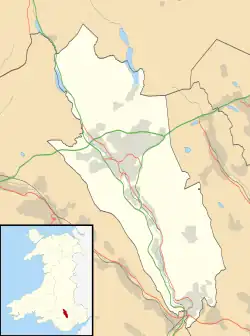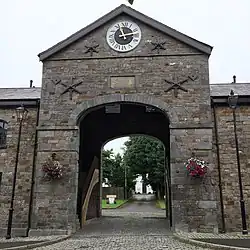Dowlais
| Dowlais | |
|---|---|
 The Guest Memorial Library | |
 Dowlais Location within Merthyr Tydfil | |
| Population | 6,926 (2011 census) |
| OS grid reference | SO075075 |
| Principal area |
|
| Preserved county | |
| Country | Wales |
| Sovereign state | United Kingdom |
| Post town | Merthyr Tydfil |
| Postcode district | CF48 |
| Dialling code | 01685 38 |
| Police | South Wales |
| Fire | South Wales |
| Ambulance | Welsh |
| UK Parliament | |
| Senedd Cymru – Welsh Parliament | |
Dowlais (Welsh pronunciation: [ˈdɔu̯lai̯s]) is a village and community of the county borough of Merthyr Tydfil, in Wales. The name is derived from the Welsh du meaning 'black' and glais meaning 'stream'.[1][2] Dowlais is notable within Wales and Britain for its historic association with ironworking; once employing, through the Dowlais Iron Company, over 7,000 people, the works being at one stage the largest in the world.[3][4]
Governance
Dowlais was originally part of the parish of Merthyr Tydfil. In 1872 the population was 15,590.[5]
Dowlais was an electoral ward to Mid Glamorgan County Council from 1973 to 1996.[6] At the 2011 census the electoral ward had a population of 6,926,[7] The population of the Community was 4,270 at the 2011 census following the exclusion of Pant.[8] Since 1996 Dowlais has been a ward to Merthyr Tydfil County Borough Council. In 2003 Dowlais was represented by an independent councillor, John Pritchard, who was also Mayor of Merthyr Tydfil.[9]
History
In 1965 Welsh historian Frederick Rees[10] documented: 'In September, 1759, a partnership of nine persons, including some local names and that of Isaac Wilkinson, was formed with a capital of £4,000 to set up a furnace or furnaces near Merthyr on the banks of the stream called the Dowlais'[11] (Isaac Wilkinson was a pioneering English industrialist who had bought the Bersham Ironworks, near Wrexham in north-east Wales.) The partnership took out a lease from Lady Windsor, the widow of Herbert, Lord Viscount Windsor. The terms of the lease were extremely favourable; they comprised a yearly rent of £31 and without any requirement to pay royalties on the iron and coal extracted from the site, which prompted Rees to comment that 'the prospects were considered very doubtful.'[12] In 1767, the partnership offered John Guest from Broseley in Shropshire the post of manager of the works because of his knowledge of the Coalbrookdale method of smelting iron with coal. For some years, Guest didn't make much headway. But, by 1782, when he became a partner, the ironworks were 'well established'. And, following the involvement of successive members of his family, the works became extremely successful.
By the mid-1840s there were between 5000 and 7000 men, women and children employed in the Dowlais works.[13] During the early to mid 1800s the ironworks were operated by Sir John Josiah Guest and, from 1833, his wife Lady Charlotte Guest. Charlotte Guest introduced welfare schemes for the ironworkers. She provided for a church and a library. The school, which dates from 1819, was improved and extended, becoming "probably the most important and most progressive not only in the industrial history of South Wales, but of the whole of Britain".[14] In the 1850s, after Sir John's death, the works existed under the control of a board of trustees.[15] In 1865 the Bessemer steel making process was introduced to Dowlais, with £33,000 being spent on a new steelworks.[16] And, following the involvement of successive members of his family, the works became extremely successful. As Welsh historian John Lloyd put it in 1906: 'the Dowlais Works are known to all the world, ranking as one of the largest in the United Kingdom ....'[17]
Steel production at Dowlais eventually ceased in 1936 due to the Great Depression. However, the iron foundry continued until 1987.

Notable buildings
Little remains of the works that once sustained the community throughout the Victorian era until the 1930s, the two notable buildings that remain are the Engine House, now used a community centre and the stable block which is now social housing.
Dowlais House, which has now been demolished, was once home to Sir John Josiah Guest and Lady Charlotte Guest, and it was at Dowlais House that Lady Guest translated the Mabinogion. The Guest Memorial Library (1863); commissioned by Lady Guest and designed by Charles Barry, still stands.
St John's Church, a Grade II listed building, contains the tombs and burial places of several notable people, including Sir John Guest who had the church built in 1827. St John's closed in 1997 but has received several hundred thousand pounds of Welsh Government money to preserve it.[18]
In its heyday, Dowlais had numerous nonconformist chapels. Almost all have disappeared although the buildings of Bethania (Independent) and Hebron (Calvinistic Methodist) are now used by evangelical congregations. Others have been demolished including Bryn Seion and Gwernllwyn.
Sport and leisure
Dowlais is home to rugby union club, Dowlais RFC.
Notable residents
- Laura Ashley, fashion designer
- Dai Astley, association footballer
- Richard Davies, actor
- Thomas Nathaniel Davies, artist
- David William Evans, lawyer and international rugby union player
- Horace Evans, 1st Baron Evans, royal physician
- Lady Charlotte Guest, first translator of the Mabinogion into English
- Ivor Guest, 1st Baron Wimborne, industrialist
- John Josiah Guest, engineer
- Richard Harrington, actor[19]
- Sue Harvard, operatic soprano
- Robert Alwyn Hughes, artist
- Heinz Koppel, artist
- Gustavius Payne, artist
- Robert Rees, tenor
- Glanmor Williams, historian
- Gwyn Alf Williams, historian
Notes
- ^ "Geiriadur Prifysgol Cymru".
- ^ "Geiriadur Prifysgol Cymru".
- ^ "Dowlais Ironworks, Merthyr Tydfil (34084)". Coflein. RCAHMW. Retrieved 16 March 2023.
- ^ Newman 1995, p. 446.
- ^ "Dowlais Glamorgan". Vision of Britain. University of Portsmouth. Retrieved 17 January 2016. (info reproduced from the 1872 Imperial Gazetteer of England and Wales)
- ^ "Mid Glamorgan County Council Election Results 1973-1993" (PDF). The Elections Centre (Plymouth University). Retrieved 15 April 2019.
- ^ "Dowlais Ward: 2011 Census: Census Area Statistics". National Statistics: UK government. Retrieved 23 January 2016.
- ^ "Community population 2011". Retrieved 9 November 2015.
- ^ "Civic cheerleader on the taxes". Wales Online. 1 July 2003. Retrieved 17 January 2016.
- ^ See also Jones 2001.
- ^ Rees 1965, p. 133.
- ^ Rees 1965, p. 133.
- ^ Birch 1967, p. 255.
- ^ Birch 1967, pp. 291-5.
- ^ Birch 1967, pp. 291-5.
- ^ Birch 1967, p. 358.
- ^ Lloyd 1906, p. 19.
- ^ Katie Sands (29 October 2015). "Church that hasn't been used for 20 years to get £100k cash boost to help convert it into 20 flats". Wales Online. Retrieved 16 January 2016.
- ^ "Gurnos-born actor Harrington nominated for S4C drama role". Wales Online. 21 March 2013. Retrieved 3 July 2025.
References
- Birch, Alan (1967). The economic history of the British Iron and Steel Industry 1784-1879. London: Frank Cass and Company. ISBN 0-415-38248-3. Retrieved 5 July 2025.
- Jones, Evan David (2001). "Rees, Sir James Frederick (1883 - 1967), Principal of the University College at Cardiff". In Jenkins, R.T.; Jones Jones, E.T.; Roberts, Brynley F. (eds.). Dictionary of Welsh Biography. Aberystwyth: The National Library of Wales. Retrieved 5 July 2025.
- Lloyd, John (1906). The early history of the old South Wales iron works 1760 to 1840. The Bedford Press.
- Newman, John (1995). The Buildings of Wales Glamorgan (Mid Glamorgan, South Glamorgan and West Glamorgan). London: Penguin Books. ISBN 0 14 071056 6. Retrieved 5 July 2025.
- Rees, J.F. (1965). Studies in Welsh History (Second ed.). Cardiff: University of Wales Press.
External links
- Old Merthyr Tydfil: Dowlais - Historical Photographs of Dowlais, Merthyr Tydfil.
- Photos of Dowlais and surrounding area on geograph.org.uk
